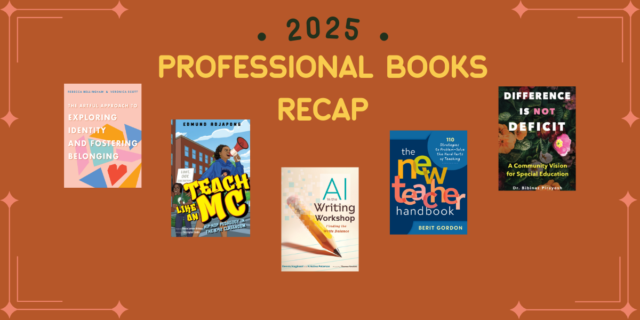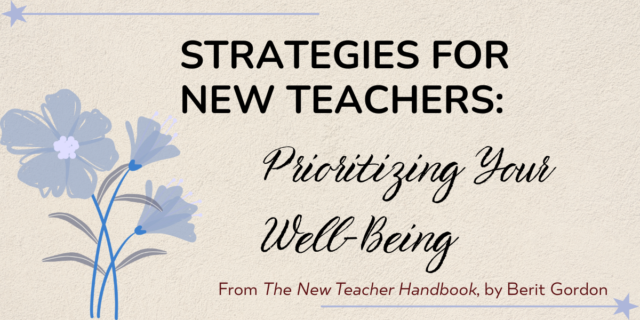
The following is adapted from The New Teacher Handbook by Berit Gordon. Here, you’ll get help prioritizing your time, energy, and well-being to have a rich life in and out of teaching.
How do I manage the workload if I never feel done?
- Budget a realistic time frame to complete a must-do task. Commit to using only the allotted time. Stop when the timer goes off, even if the work isn’t precisely to your standards. Trust me, the world will keep turning if you do some tasks as C-level work. A+ that they’re done.
- Pomodoro Technique: Set a twenty-five-minute timer to work on one task, then take a five-minute break to reset your brain and start again. Neuroscience backs up that short time frames with breaks allow us be more productive and pace ourselves when to-do lists are long.
- Find a parallel play work partner: Facetime or get on a Zoom together and silently get stuff done. Hold each other accountable for an end time. Set three priorities for the day. Knock those out, and anything else that gets done is a bonus.
- Answer emails at one set time each day. Read them whenever, but only compose responses during that one limited time. You’ll get less back and forth, you’ll reply when you’re calm and rested, and often, the sendee has figured it out or moved on. One less email chain to contend with.
- Budget at least ten hours a week for planning, grading, emails, and all the rest; some weeks more and occasionally some less. You’ll be happier having budgeted this time (and sometimes not needing it all) than the other way around. Allot those hours so your schedule is personalized around other commitments and when you feel most productive.
How do I maintain work-life boundaries?
- Enjoy leaving right at contract hours on occasion.
- Your brain will thank you if you doom scroll less and do any hobby with your hands just a few times a week: think fifteen minutes of friendship bracelets, beading, sketching, working on a puzzle, or building a LEGO tower. The constant stimulation of a classroom means your brain needs these moments of “focused” distraction, soothing it into a calm state.
- Say, “Thank you for thinking of me. Let me get back to you,” when asked to take on extra roles or attend evening or weekend events.
How can I make lesson planning easier and less time-consuming?
- Online resources (including AI tools) can be helpful but possibly overwhelming because of the number of options available or the lack of quality control. Bookmark a couple of go-to resources with quality materials from actual educators.
- Set hard deadlines for online searches.
- Borrow from colleagues whenever possible.
- Stick to predictable lessons that look similar every day. Change only the content, not the structure.
- Carve out a class period or subject into four to five chunks (components) that repeat most days. The routines and procedures for these components will be the same almost daily; only the content will change.
- Write one to three possible sentence starters for each component, introducing what you (or your students) will do or say.
- Create one or two alternate planning templates for alternate class structures, such as unit intro days and assessment days, which might have different components.
- Embrace a replicable class structure for almost every day. Start by breaking up your class period into these short chunks of time. At a minimum, these will include:
- a quick warm-up or welcome;
- your whole-class instruction;
- independent or small-group work, when students try out the skill you taught; and
- a closing or share to recap the learning.
How do I spend less time marking or grading classwork and homework?
- Personalize homework. Help students determine what skills they need to practice and assign homework based only on those skills (or let them choose accordingly).
- Reduce what you collect. Don’t reduce what students do as practice. Practice means progress. Just don’t collect or assess them on everything.
- When appropriate, have students present their work or a portion of it in class. You can grade that portion of the assignment as they present it, and you’ll get an overview of their work. This saves time because we often go through the assignment twice, once to understand it and the second time to evaluate it.
- Use AI to create and mark quick assessments. Use Classtime, MAGICSCHOOL, Diffit, or some other reputable AI platform to pull from pre-created questions and immediately see the results. You can also use it to score assignments automatically.
How can I spend less time providing feedback on end-of-unit assignments?
- Look at completed assignments holistically and provide general feedback to the class on two to three areas of strength and weakness.
- Speed up feedback with numbered comments. Create a document with frequently used comments and assign each with a number. As you read the work, insert the relevant numbers only, adding one or two personalized remarks at the end if time allows. When you return the work, give students time in class to refer to the separate document that contains the explanations of the numbers.
- Use single-point rubrics. Instead of creating a multiple-column rubric, write the expected criteria in one column, leaving space to the right for not meeting that expectation and space to the left for having exceeded it. In those columns, you provide concise feedback.



